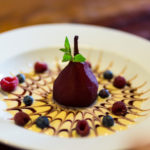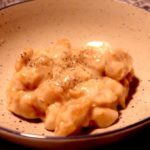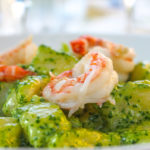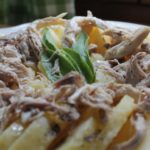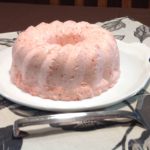CHESTNUT SOUFFLÉ
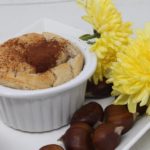
These days, most recipes use some pre-cooked ingredients, but for these chestnut soufflés I prefer using fresh chestnuts and boiling them instead of using a chestnut jam, as is indicated in modern recipes. As in other cases, I was inspired by the father of Italian cuisine, Pellegrino Artusi, and his Science in the Kitchen and the Art of Eating Well.
While jam gives an excessively sugary taste to the soufflés, this preparation is lighter and more elegant.
Serve them immediately without trying to remove them from their moulds.
Prep Time: 20 minutes | Cooking Time: 40 minutes | Total Time: 60 minutes | Yield: Makes 4 servings.
Ingredients
- 5 oz. (150 g.) chestnuts
- 3 tablespoons (25 g.) icing sugar
- ¼ tablespoon vanilla
- 2 medium egg yolks
- A dash of marine salt
- ¾ cup medium egg whites (about 3 + ½ eggs – 140 g.), room temperature
- White sugar for ramekins
- Unsalted butter (for ramekins)
Special Equipment
- 4 (6-ounce) ramekins
Instructions
Boil the chestnuts in a pot with water for 10 minutes. Peel them, and cook them in milk for 30 minutes.
Put the chestnuts and milk in a bowl and, with an immersion blender, blend them. Pass through a sieve. Add the vanilla, yolks, and mix.
Heat the oven, 375 F (180 C), convected.
Butter ramekins, making upward strokes up the sides with a pastry brush. Sprinkle with sugar, tilting to coat completely and tapping out any excess. Arrange prepared ramekins on baking sheet.
Beat egg whites and a pinch of salt in the bowl of a stand mixer fitted with the whisk attachment on medium speed until frothy, about 2 minutes. Gradually add icing sugar, 1 Tbsp. at a time, and beat until medium peaks form, 6 to7 minutes.
Using a rubber spatula, fold one-quarter of the beaten egg whites into chestnut mixture to lighten. Fold in remaining egg whites in 2 batches. Divide batter among prepared ramekins, filling completely.
Transfer baking sheet with ramekins to oven and bake soufflés until puffed and tops feel firm to the touch, 25–28 minutes.
